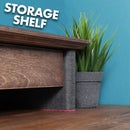Introduction: 3D Wooden Head PPE Storage
I'm always loosing my PPE (Personal Protective Equipment) so I decided to create a place to store them. I didnt want your standard cabinet/shelf so I decided to go with a kind of manikin head. This was made for the 2x4 contest so thats what I used. I thought pallet would could also be used but MDF would be best.
Watch me make it here:
Materials used:
- 1x 2400mm x 47mm x 100mm (8ft x 2in x 4in) Pallet Wood can also be used but I think MDF is best.
- Wood Glue
- Super Glue
- Wood Filler
- Milliput Epoxy Putty
- Wooden Dowels
- Self Adhesive Paper
- White Spray Primer
- Grey Spray Gloss Paint
Tools Used:
- Mitre Saw
- Table Saw
- Bandsaw
- Drill
- Angle Grinder with Roto Rasp
- Belt Sander
- Rasps/Files
- Sand Paper
Step 1: Create Templates
I started by slicing a model of a head in google sketchup. I did this in 11mm stages. I started from the bottom and worked my way up to the top.
I have all the templates available on my facebook page here:
https://www.facebook.com/AverageJoesJoinery/posts/...
There are 20 layers in total.
I printed these off onto self ashesive paper to then stick to the wood.
Step 2: Cut & Rip Wood
I used the largest template which was #10 to measure the length of wood I would need. I gave it a rough mark and used my mitre saw to cut it to length. I repeated this until I had around 5/6 lengths.
Then I used my table saw to rip each piece to 11mm thick (The same as the 3D model slices)
These pieces now measure: 100mm x 11mm
Step 3: Glue/Cut Layers
I dont have many clamps so I used a trick to glue the strips together.
I added 3 dabs of super glue with wood glue inbetween. This way the super glue dries almost instantly, holding the wood together and then the wood glue has time to dry and give it real strength.
I glued them up so they were big enough to fit the templates on. Most were 3 pieces wide but a couple where 4 pieces wide.
I then just used my bandsaw to cut them out.
Step 4: Glue Layers Together
I drilled holes to accept some dowels to help with alignment while gluing. There are dots on the templates for the dowels.
I didnt want the pieces moving around while I was gluing, the dowels stopped this from happening.
The real strength comes now with all the surface area for wood glue, thats why the joints earlier where fine with just super glue and no clamps.
I applied a couple of clamps and left it to dry over night.
Step 5: Shape the Head
I used a Roto Rasp disc in my angle grinder to smooth out the layers and round over the head shape. This made quick work of getting the rough shape defined.
I then used my belt sander to further smooth and define the shape. I finnished up with some hand rasp, files and sand paper until I was happy with the shape.
Step 6: Fill Gaps
I was left with some gaps in the layers and 2 holes in the top of the head from the dowels.
I used wood filler to fill these, I just sanded it smooth when It was fully dry.
On the ears I was unable to get a shape I was happy with so I added some Milliput epoxy putty and shaped them into more of an ear shape. When dry it is rock hard and very easy to sand smooth.
Step 7: Spray Paint & Its Done
I used some cheap white spray primer to give a base coat before I used some grey gloss spray paint for the final coat. Of course any colours could be used.
Once it was dry I could place on PPE and now I will know where everything is. I will save a lot of time searching for my safety gear from now on.

Participated in the
Unusual Uses Challenge

Participated in the
Pallet Contest













